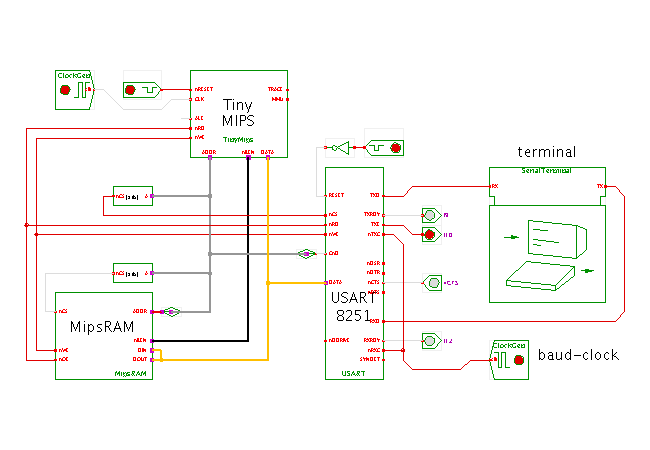

 |  |
 Description
This applet demonstrates a serial interface
with a serial terminal connected to the microprocessor system
via the Intel 8251 asynchronous receiver and transmitter chip.
Description
This applet demonstrates a serial interface
with a serial terminal connected to the microprocessor system
via the Intel 8251 asynchronous receiver and transmitter chip.
Please check the introductory applet for the introduction and description of the TinyMips processor. The hardware structure used for this applet consists of the processor, some glue logic, a single RAM component that stores both the program and the working set data, and the UART8251 interface chip. See the UART 8251 overview page for details about the asynchronous receiver and transmitter chip. The transmitter output of the terminal (the keyboard) is connected to the 8251 receiver input, while the 8251 transmitter output drives the terminal receiver input (its display). The terminal uses its own GUI window; just click the symbol of the terminal in the schematics to open or close that GUI window.
The bus interface of the 8251 UART is based on a bidirectional 8-bit databus and requires two memory addresses to access the internal on-chip registers. To this end, the MIPS address bus bit A2 is connected to the CnD input of the 8251 UART, which selects between command (CnD=1) and data (CnD=0) transfers. Therefore, command transfers are selected whenever A2 is high, while data transfers are selected when A2 is low. The bidirectional 8-bit DATA bus of the UART is directly connected to the lower eight bits of the MIPS 32-bit data bus. The simulation model of the 8251 ensures that the upper data bits are ignored during write transfers, and are zeroed during read operations.
The address-decoder is set up to activate the UART for the physical addresses 0x00080020 (A2=CnD=0, data transfers) and 0x00080024 (A2=CnD=1, command and status transfers). Again, the static MMU of the TinyMips is disabled, and the virtual addresses used in the program are also the physical addresses that appear on the external address bus. Therefore, the C-program defines the (virtual) base address of the UART to be at location 0xa0080020:
MIPS virtual address physical address UART register
a008.0200 a008.0200 data
a008.0204 a008.0204 command/status
The program (see the link below for the full sourcecode) defines a few simple utility functions to write data into the control and data registers of the 8251, and to read the receiver buffer and status register. To initialize the 8251, the functions uartAsyncMode() and uartCommand() are called at program start. The supplied parameters select asynchronous communication with eight databits, two stopbits, and no parity. Also, the clock prescaler is disabled.
The main part of the program then consists of an endless loop that first increments the variable count and then calls the sayHello method. This method in turn calls the uartSendDataPolling method to output a constant string followed by the count value in four-digit hex format.
Despite the slow input clock of just 10 kHz used here, the TinyMips processor can still write characters to the UART much faster than the UART can output them at the selected baud-rate of 600 baud. Therefore, the uartSendDataPolling method first executes a loop that repeatedly checks the TXEMPTY status bit of the UART. This simple but also rather inefficient technique of active waiting for peripheral devices is called polling. (Naturally, the second call to uartReadStatus inside the loop-body is redundant. It was only added to store the status value from the UART to main memory, which means that you can easily check the status value during program execution.) Once the UART indicates that its transmitter is empty, the new data value is written into the transmit buffer register via uartSendData immediately.
Usage
Wait until the applet is loaded, then click on the symbol of the serial terminal to open the GUI window of the terminal. After the program has completed its initialization sequence, the transmitted characters will be displayed by the terminal. Naturally, you can also open the memory-editor (via popup > edit) to watch the memory accesses during program execution. The memory editor highlights the last read operation in green color, and the last write operation in cyan color.
If you want to change the simulation speed, just select 'edit' on the clock-generator component, then edit the value of the clock-generator 'period' property, and select 'apply' (and 'ok' to close the clock-generator config dialog). The default clock rate is slow enough to allow you watching the memory accesses during the main loops of the program.
Similarly, open the TinyMips user-interface window (via popup > edit) to watch the current register values.
The binary program running on the processor was compiled and linked with the GNU gcc (2.7.2.3) and binutils cross-compiler toolchain on a Linux x86 host, with the final ELF loading and relocation done via the Hades Elf2rom tool. See
Run the applet | Run the editor (via Webstart)